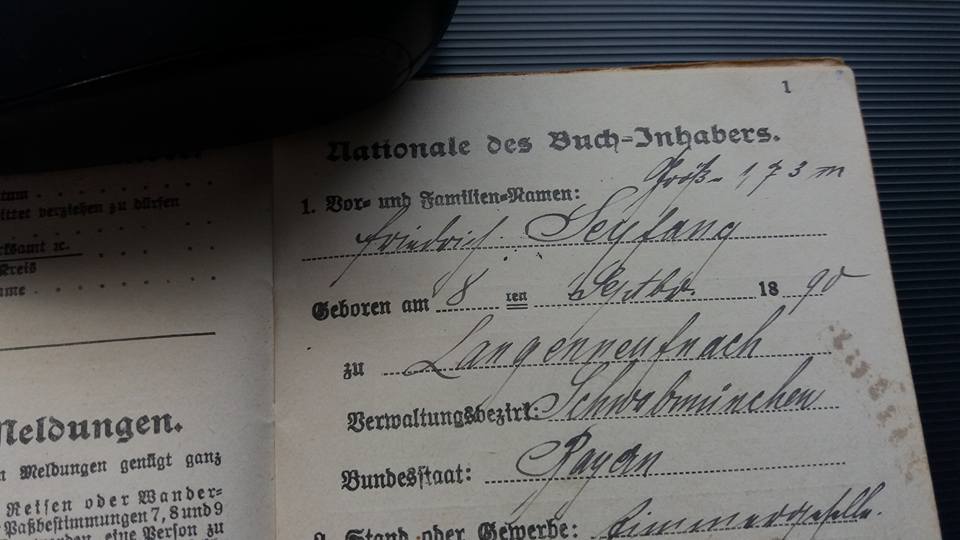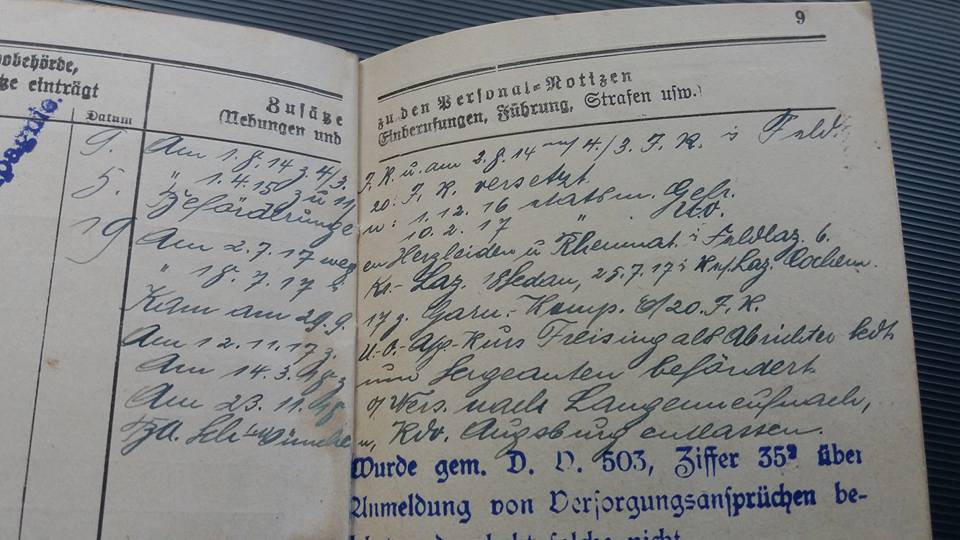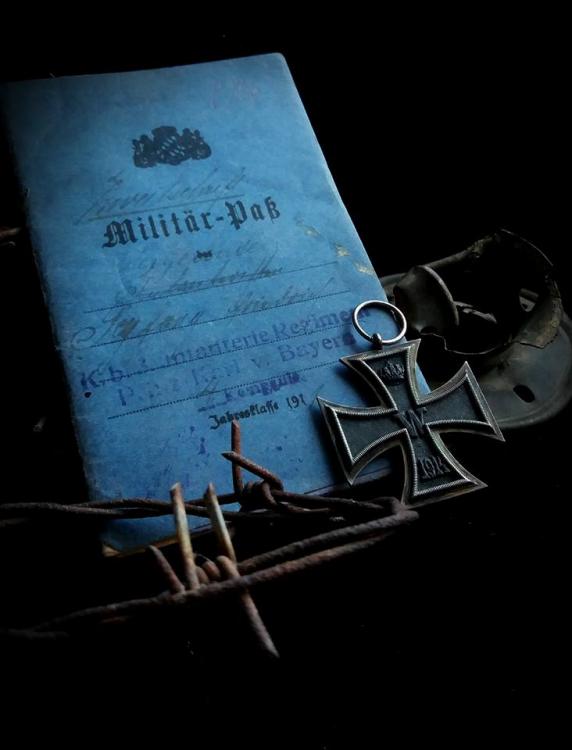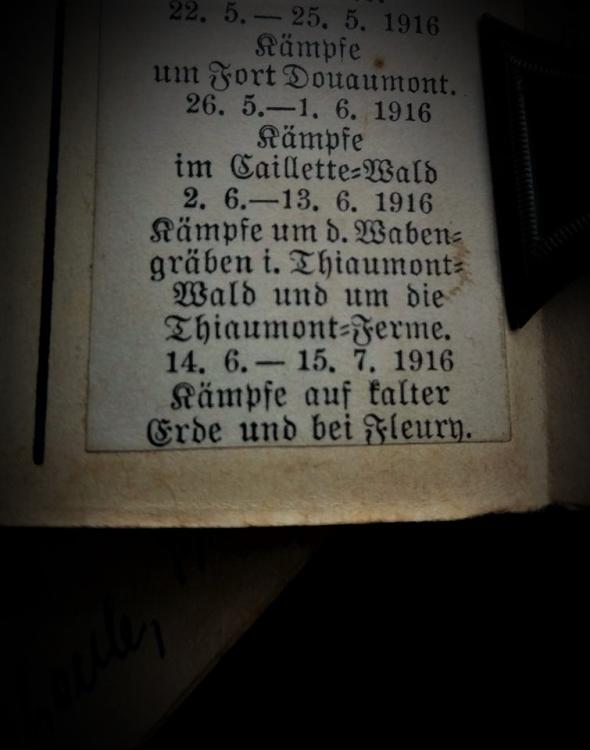-
Posts
180 -
Joined
-
Last visited
Content Type
Profiles
Forums
Blogs
Gallery
Events
Store
Everything posted by Dansson
-

One-piece-constuction EK I 1939
Dansson replied to ulric's topic in Germany: All Eras: The Iron Cross
One-piece crosses exist yes, but unfortunately this cross is a fake. A known and common fake and for starters, Katz & Deyhle made EK2, but not EK1! I hope you can return this piece to the seller -
Good original private purchased Deumer. The L/11 marking is a variation of the marking called "boxed L/11".
-

Another Souval EK I with brass core
Dansson replied to ulric's topic in Germany: All Eras: The Iron Cross
It's an authentic Souval. Quite early with a brass core. -
I was asked to post my research done on one of my MP's, this was the first item I ever "researched" some time ago already. I haven't had the time to "re-read" it and it might have a few typos etc. Nevertheless, I hope you find some joy in my research I did and the text I wrote. Unfortunately I have not saved more pics of the MP on my computer, but if you wish to see more pictures, I'd be glad to take a few shots. This is the Story of Friedrich Seylang, a bavarian soldier who raised in the ranks up to the rank of Sergeant. A man who fought on the Western front against the French and the Brittish, a man who outlived the hell of Verdun “The Bonegrinder”, fighting for his life in Verdun, fought in places like Kalter Erde, Thiaumount Wald, Thiaumont Ferme, Caillette Wald, Fleury, Fort Douaumont and the feared Waben-Gräben. In the fights of Verdun he showed acts of courage during a few of the fearsome battles that raged in Verdun and was awarded the Iron Cross for his actions there. His career includes three transfers within his division. He was wounded in action in July 1917 and after recovery spent the rest of the war as most likely a trainer at the Garnison. He was awarded for bravery, the iron cross 2nd class and the M.V.K. 3rd class with Crown and Swords. This is his story; Friedrich Seylang was born 8th September 1890 in the community of Langenneufnach, Augsburg, in Bayern. He was baptized in a Catholic church which is very common in Southern Germany. He begun his National service in the military 11th October 1911 in the 4th Company of the Bayerisches 3. Infanterie-Regiment “Prinz Karl von Bayern”. He received the training of an infantry soldier with the Gewehr 98, and he ended his National service 19th September 1913. Seylang served the whole war in the 2. Königlich Bayerische Division. In the beginning of the war he served in the same unit as he had received his military training in 1911. Which was the 4th company of the Bayerisches 3. Infanterie-Regiment “Prinz Karl von Bayern”, which was a part of the 3. bayerische Infanterie-Brigade. He entered service in the First World War 1.8.1914. The early war. 1.8.1914 - 1.4.1915 Seylang entered service 1.8.1914 and his “first big battle” battle was the battle of Lothringen. Seylangs unit faced the French forces at the city of Saarburg 20 August. Seylangs unit was apart of the 6. Armee, however during the first stages of the war and during this battle the 6.-, and the 7. Armee had combined command. During this stage Seylang served in the 6. Armee, 1. Armee Korps, 2. Bayerische Divsion, 3. Infanterie Regiment. Lothringen and the first battles 1914 The French had attacked on the german positions since the 8th August in the area which resulted that the Germans were withdrawing in some places. The 10th of August the 1.Armee Korps crossed the border, and the 2. Bayeriche division was standing ready for combat just outside Badonviller (another source states just outside Blâmont, possible that both are true as a division is a quite large unit, and there’s only 10km distance between these two villages.). The Division rested a day there. On the following day the Division attacked Badonviller on the 11th August. The French launched an attack on the Bayerische 1. Armee Korps on the night of 11th August, but the Germans repulsed the attack. Parts of the 1. Armee Korps were forced to retreat because the flanks broke, which the XXI and XVI Armee korps in Vosges north of Metz, failed to hold. This resulted that parts of the 1. Armee Korps moved quickly to Eyweiler and Seyweiler. On the following day, 12th August, the 2 Bayerische Division took Badonviller. In the battle that occurred on the 12th August, hundreds of soldiers lost their lives and a small massacre took place, 84 houses were burned, 14 civilians deported and 12 civilians were executed. It’s unknown if Seylang played an active part in these questionable events. On the 14th of August 1914 the French offensive began in the region, the Germans withdrew during the day and on the following day on the 15th of August the “dug-in” Bavarian infantry units managed to inflict several casualties on the French infantry as they attacked. Besides this the German long range artillery had been able to bombard both the French artillery and infantry undisturbed. The Germans offered tough resistance but were forced to retreat during the following days. The 20th of August 1914 the Germans launched a powerful counterattack on Lothringen, Seylangs regiment faced its “first big battle” in Saarburg. The Germans managed to succesfully to conquer the area on the 22. August with the counteroffensive, by defeating the French troops which started to retreat in disorder. 24th August the division reached the area of Bazien The whole German 6. Armee was ordered to attack the Trouée de Charmes, because the German high command saw a chance to surround large quantities of French forces. The attack was ordered almost directly after the French suffered a defeat in Lothringen and was now retreating in disorder. The Trouée de Charmes was a 70 km wide line of defence positions and fortifications, located between Nancy and Épinal. The fighting itself between the 24th August and the 26 August took place between Lunéville and Charmes. The German troops failed to make a breakthrough and were forced to retreat. After the German defeat at Trouée de Charmes the French managed during late August until early September to push Germans back and regain the line of 14th of August. Not a mile was gained, but thousands of lives were lost. The 2. Bayerische Division was transferred in mid-September alongside with the 1. Armee Korps to Gouy. Directly after arrival on the 22nd September, the 2. Bayerische Division, which Seylang was stationed in, they begun to play their part in the “Race to the sea”. On the following day,September 23rd they arrived to Péronne at the Somme. The high command of the division had to cancel the plans of the offensive, because the left flank was seriously threatened, due that the French advanced and formed a bridgehead on the east side of the Somme at Péronne. Which resulted in that the 2. Bayerische Division relieved the 5.inf.division on 26th September and “dug-in” in the trenches for several months in Péronne and west from St.Quentin. The division was stationed here for several months and Seylang was stationed here in stuck in trench warfare with his unit. Seylang remained in these positions until the 1.4.1915 when he received a transfer to a new unit. 8.8. - 19.8. 1914 •Grenzschutzgefechte in Lothringen 20.8. - 22.8.1914 -Kampf um Lothringen -Saarburg 22.8. - 14.9.1914 – Schlacht bei Nancy-Épinal •Battle of the Trouée de Charmes 23.9. - 6.10 – Schlacht an der Somme bei Péronne 7.10 - 10.10.1914 – Stellungskämpfe westlich St.Quentin 10.10.1914 – 31.3.1915 - Stellungskämpfe an der Somme A new regiment The 2. Königlich Bayerische Division was triangularized in April 1915, which resulted the sending of the Bayerisches 3. Infanterie-Regiment “Prinz Karl von Bayern” to the recently formed 11. Bayerische Division. When the whole 3. Bayerische Infanterie-Brigade along with the Bayerische 3. Infanterie-Regiment was sent to the 11. Bayerische Division, Seylang wasn’t sent in April 1915 alongside with the Regiment to the new 11. Bayerische Division. He got instead transferred within the 2. Bayerische Division into the 11. Company of the 20. Infanterie regiment “Prinz Franz”, in the 4. Bayerische- Brigade. He entered service in his “new unit”, the 20 Bayreische Infanterie Regiment “Prinz Franz”, on the 1.4.1915. Seylang continued his service, now in the 20.inf.reg from starting from 1.4.1915 and onwards participating in the trench warfare in different sections. The regiment was thrown in a big battle again on the 10th october at la Bassée and Arras. Seylangs 2. Bayerische Division along with the 1. Bayerische Division relieved the 4.Armeekorps from the area of Lille, took over and continued immediately the defence of the western forefields of the Vimy positions and managed to repulse all further charges and attacks at Thelus. The regiment was stationed in the “region” until the 9.5.1916 and participated in several battles which consisted mainly of trench warfare in the Artois and Flandern area where Arras, Neuville St.Vaast and la Folie were located. 1.4. - 5.10.1915 Westl. St. Quentin •1. bis 25. April – Heeresreserve •26. April – Handstreiche gegen das Efeuwäldchen •16. Juni – Gefecht bei Rolincourt 20. Juni bis Oktober – Stellungskämpfe 6.10 - 13.10.1915 Herbstschlacht bei la Bassée und Arras 14.10 - 29.10.1915 Stellungskämpfe im Artois 30.10 - 31.10.1915 Gefecht bei la Folie 1.11.1915 - 22.1.1916 Stellungskämpfe im Artois 23.1 - 28.1.1916 Gefecht bei Neuville St.Vaast 29.1 - 7.2.1916 Stellungskämpfe im Artois 8.2 -10.2.1916 Gefecht bei Neuville St.Vaast 11.2 - 9.5.1916 Stellungskämpfe im Artois 9.5 - 15.7.1916 . VERDUN The unit was transferred 9th May 1916 to Verdun, the previous years were only the calm before the storm of steel that was about to occur. Attacks, repulsing the French attacks and counterattacks were daily. The 22nd of May the French launched an offensive at the Fort Douaumont area where Seylang was stationed and “Hell broke out” with casualty rich heavy fighting around the Fort Douaumont. The control of the western parts of the Fort was lost the same day. The next day on the 23rd of May the Germans attacked at full force to regain the full control of the Fort and the surrounding area, the Germans attacked with the support of artillery and with heavy “Minenwerfer”. On the morning of the 24th May the Fort was back in German hands and until the 25th of May the Germans managed to cut off retreat of the French and took a large amount of prisoners and succeeded in repulsing the French attack on the 25th. After these events the unit fought from 26.6 - 1.6.1916 in the Caillette Wald between Fort Douamont and Fort Vaux in verdun. On the 1st of June the Germans attacked on the trenches southwest of Fort Douamont and on the next the day the units on Seylangs flanks captured the top of fort Vaux and heavy fights around Vaux begun when the French tried to re-capture Vaux, but the units that were defending the area (including Seylangs unit) managed to repulse the fierce attacks concluded by the French. Fort Vaux ran out of water the 7th of June and Fort Vaux surrendered. On the same day, 7th of June 1916, in the heart of the “Bonegrinder” Verdun, Seylang had fought with courage and bravery during the hard days and he was awarded for his in front of the enemy the Eisernes Kreuz 2.klasse. On the following day, 8th of June 1916, Seylang charged along with his unit through the Thiaumont wald, attempting to gain control over the Waben-Gräben and the Thiaumont farm, which would open a way to Fleury. The Germans attacked several time during the day but failed to gain control over the Waben-Gräben. 12th June, the shells had desolated the battlefield when the German assault on the Waben-Gräben began, or what was left of it. The Germans gained control of the Waben Gräben and continued and started to fight of the Thiaumont farm which led to horrible casualties on both sides. Heavy fights in the Kalter Erde and the Thiaumont strongpoint took as well. place. On the 22nd of June the Germans launched an offensive in the area and to soften up the French before the assault, the Germans fired 116,000 Diphosgene gas grenades on them and on the 23rd of June the Bavarians managed to take the Strongpoint of Thiaumont and Fleury. Thiaumont was the center of hard fights between 24th of June and 7th of july and switched control several times, but at the end the Germans were the ones that were in control of the strongpoint Thiaumont. Between 23rd of June and 17th of August the village Fleury changed owner 16 times. The 2nd of September 1916 the 1st Bavarian Armee Korps was transferred along with Seylangs unit away from verdun to “rest” on another front section. For the German High Command the "Schlacht bei Verdun" ended on the 9th of September 1916. From the 10th of September the "Stellungskämpfe vor Verdun" started. (Verdun) 22.5 - 25.5.1916 Fort Douaumont 26 - 1.6.1916 Caillette Wald 2.6 - 13.6.1916 (E.K.2 - 7.6.1916) Wabengräben in Thiaumont Wald u. Thiaumont Ferme 14.6. - 15.7.1916 Kämpfe auf kalter Erde und bei Fleury 16.7 - 9.10.1916 Kämpfe zwischen Maas und Mosel; Wald von Apremont und Ailly -Maas is in French Meuse Somme and the rest of the War at the front. Seylang was stationed 10th of October northwest from Sailly-Saillisel. His unit was stationed at these positions and repulsed the Brittish attacks and held the positions until the 5th november when they got relieved and sent to another front section. The rains on 23rd of October onwards had messed up all plans for both sides of major offensives. During a long time of trench warfare and smaller battles from 16.11.1916 until 7.5.1917, Seylang was promoted to the rank of Gefreiter 1.12.1916. The promotion from private to the rank Gefreiter usually was for distinguished privates. Not long after, in the winter of 1917 he was promoted to Unter-Offizier on the 10th february 1917. From actions during the battles fought in the spring/winter 1917, he was awarded the Bayerische Militär Verdienstkreuz 3.rd class with Swords and Crowns on the 19.3.1917 for bravery in battle in front of the enemy. Seylangs unit was sent to the second battle of the Aisne 7.5.1917 and the Chemin des Dames which was described as heavy for his regiment as the French charged their trenches frequently. Nevertheless, the French were forced to retreat as the Bavarian Regiment managed to repulse the attacks. The regiment remained in the area and shortly after, Seylang was wounded 1.7.1917 in the Argonne. (Somme) 10.10 - 6.11.1916 Schlacht a.d. Somme 16.11.1916 - 6.5.1917 (Promoted to Gefreiter 1.12.1916, Promoted to Unter Offizier 10.2.1917) (M.V.K. 3.kl - 19.3.1917) Stellungsämpfe auf den Maashöhen bei Lamorville- Spada u. St.Michel 7.5 - 24.6. 1917 Doppelschlacht an der Aisne und in der Champagne 25.6 - 1.7.1917 Stellungsämpfe in den Argonnen Time in the Hospitals and the rest of the War According the Militärpass, Seylang was transferred around in three different hospitals from 2.7 - 25.7.1917 where he probably remained for some time. He was probably wounded in action at the Argonne, and the wounds he sustained resulted that he was probably fit for service again, but not to frontline service. He was transferred within the regiment to the Ersatz Battalion/20-Inf.Reg, to the Garnisions Kompanie where he most likely served as a trainer for recruits. He was promoted to Sergeant 14.3.1918 and on the 23.11.1918 he was released from service as the war was over. 2.7.1917 Feld Lazarett No.6 (Can’t decypher where) 18.7.1917 Feld Lazarett Nr.18 (Lindau?) 25.7.1917 Reserve(?) Lazarett (Cochem?) 29.9.1917 transfered to the Ersatz Battalion/20th Inf. Reg., Garnision kompanie Sergeant befödert am 14.3.1918 23.11.1918 released from service in Lindau, and received 65.Mk of “Entlassungsgeld”. Thank you for reading!
-
It's an authentic early Souval.
-
Congrats on your lovely purchase! Best regards, Daniel
-
Very nice! If it will be for sale, I'd perhaps be interested.
-

German iron cross 1 class!
Dansson replied to Mr. Fischer's topic in Germany: All Eras: The Iron Cross
It's a very well knwon fake. Nothing else. The overlapping pin is just one typhical feature from this fake. This doesn't mean there would not exist any originals with long overlapping pins, there exist originals too with this feature. This cross isn't just original. It does not match any known original, no original maker, no original maker, believe me, I've been collecting Iron Crosses for years. -

EK 1870 Researching an 1870 EK awardee
Dansson replied to dond's topic in Germany: All Eras: The Iron Cross
I support the idea. -

German iron cross 1 class!
Dansson replied to Mr. Fischer's topic in Germany: All Eras: The Iron Cross
Simply, it doesn't match to any originals. There is nothing "general" that doesn't match originals, but none of the details match originals.This same fake can be found with a fake Round 3 core aswell. ID:ing fakes, Originals and manufacturers is a process that takes years to master. One thing for beginners would be the overlapping pin, it's typhical this fake along its other details. I know my answer isn't really helpful and repeats itself, but it's true that you only must look at details of each original manufacturer individually (an dvariatiosn within them) and compare the unique details to other originals and you'll soon notice what distinguishes a original from that one other original, as a side effect you'll quickly notice fakes among other anomalities when you begin to learn. This fake is usually called the Round 3 fake, as it is most often found with a fake Round 3 core, and this fake core. Do however remember there exists several original Round 3's aswell and a Round 3 on the core doesn't mean fake. My answer is just a scratch on the surface. -

German iron cross 1 class!
Dansson replied to Mr. Fischer's topic in Germany: All Eras: The Iron Cross
Sorry, it's a known fake. -
Very interesting and a really late award date! Just thinking on that the war ended only a week later.




.jpg.f0fcba5acafa9610a30a7fa0b29bd660.jpg)

